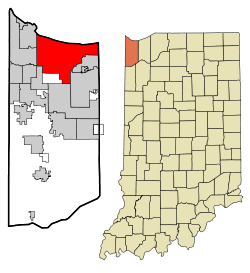Gary, Indiana | |
|---|---|
| Nickname(s): City of the Century, Magic City, Steel City | |
| Motto: "We Are Doing Great Things" | |
 Location in Lake County and the state of Indiana | |
| Coordinates: 41°35′26″N 87°20′49″W / 41.59056°N 87.34694°W | |
| Country | United States |
| State | Indiana |
| County | Lake |
| Townships | Calumet, Hobart |
| Established | 1906 |
| Incorporated | July 14, 1906 |
| Named for | Elbert Henry Gary |
| Government | |
| • Type | Strong mayor–council |
| • Body | City council |
| • Mayor | Eddie Melton (D) |
| • City Clerk | Suzette Raggs |
| Area | |
• Total | 50.663 sq mi (131.217 km2) |
| • Land | 49.932 sq mi (129.323 km2) |
| • Water | 0.731 sq mi (18.938 km2) |
| Elevation | 597 ft (182 m) |
| Population | |
• Total | 69,093 |
• Estimate (2023)[5] | 67,652 |
| • Rank | US: 566th IN: 11th |
| • Density | 1,385.55/sq mi (534.97/km2) |
| Time zone | UTC–6 (Central (CST)) |
| • Summer (DST) | UTC–5 (CDT) |
| ZIP Codes | 46401–46411 |
| Area code | 219 |
| FIPS code | 18-27000 |
| GNIS feature ID | 2394863[3] |
| Website | gary.gov |
Gary (/ˈɡæri/ GARR-ee) is a city in Lake County, Indiana, United States. The population was 69,093 at the 2020 census,[4] making it Indiana's eleventh-most populous city. The city has been historically dominated by major industrial activity and is home to U.S. Steel's Gary Works, the largest steel mill complex in North America. Gary is located along the southern shore of Lake Michigan about 25 miles (40 km) southeast of downtown Chicago. The city is the western gateway to the Indiana Dunes National Park, and is within the Chicago metropolitan area.[6][7]
Gary was named after lawyer Elbert Henry Gary, who was the founding chairman of the United States Steel Corporation. U.S. Steel had established the city in 1906 as a company town to serve its steel mills.[8] Like other Rust Belt cities, Gary's once thriving steel industry has been significantly affected by the disappearance of local manufacturing jobs since the 1970s. As a result of this economic shift, the city's population has decreased drastically, having lost 61% of its population since 1960.[9] Because of its large losses in population and deteriorating economy, Gary is often cited as an example of industrial decline and urban decay in America.[citation needed]
Although initially a very diverse city, Gary currently holds one of the nation's highest percentages of African-Americans.[10] Between 1970 and 2010, Gary maintained a 40-year record of holding the nation's largest Black population per capita.[11] The city also boasts a legacy of African-American cultural and historical feats, such as electing the nation's first Black mayor (see Richard Hatcher), hosting the first and largest National Black Political Convention, and, in 1945, becoming the first city in the Midwest (and one of the first in the entire nation) to fully integrate its public school system.[12]
Gary is serviced by the Gary/Chicago International Airport, an alternative airport to the Chicago region's two larger airports. The city's public transport is provided by the Gary Public Transportation Corporation and the South Shore Line passenger railway, which connects to the Chicago transit system. It is also home to a professional baseball team, the Gary SouthShore RailCats. In addition to its large steel mills, the city is known for being the birthplace of the Jackson family, a family of well-known entertainers whose members include singer Michael Jackson.[13]
- ^ "2014 Public Officials Directory". Lake County Board of Elections and Voter's Registration. Archived from the original on December 26, 2018. Retrieved June 30, 2014.
- ^ "2023 U.S. Gazetteer Files". United States Census Bureau. Retrieved May 24, 2024.
- ^ a b U.S. Geological Survey Geographic Names Information System: Gary, Indiana
- ^ a b "Explore Census Data". United States Census Bureau. Retrieved May 24, 2024.
- ^ Cite error: The named reference
USCensusEst2023was invoked but never defined (see the help page). - ^ Stephanie Smith; Steve Mark (2006). "Alice Gray, Dorothy Buell, and Naomi Svihla: Preservationists of Ogden Dunes". The South Shore Journal. 1: 15–21. ISSN 1933-8163. Archived from the original on September 13, 2012. Retrieved May 20, 2018.
- ^ Smith, Stephanie. "The Historical Roots of The Nature Conservancy in the Northwest Indiana/Chicagoland Region: From Science to Preservation". South Shore Journal. Archived from the original on January 1, 2016. Retrieved November 22, 2015.
- ^ "City of Gary, Indiana". www.gary.gov. Retrieved February 6, 2024.
- ^ Engel, Pamela (June 20, 2013). "Gary, Indiana Is Deteriorating So Much That It May Cut Off Services To Nearly Half Of Its Land". Business Insider. Retrieved April 6, 2014.
- ^ "Gary city, Indiana". United States Census Bureau. Retrieved April 15, 2022.
- ^ "Black Population of United States of America". United States Census Bureau. Retrieved April 15, 2022.
- ^ "Integration". Blog.history.in.gov. March 3, 2017.
- ^ Donley, Brendan (August 22, 2017). "A Day at the Beach in, Yes, Gary, Indiana". The New York Times. Retrieved August 22, 2017.




